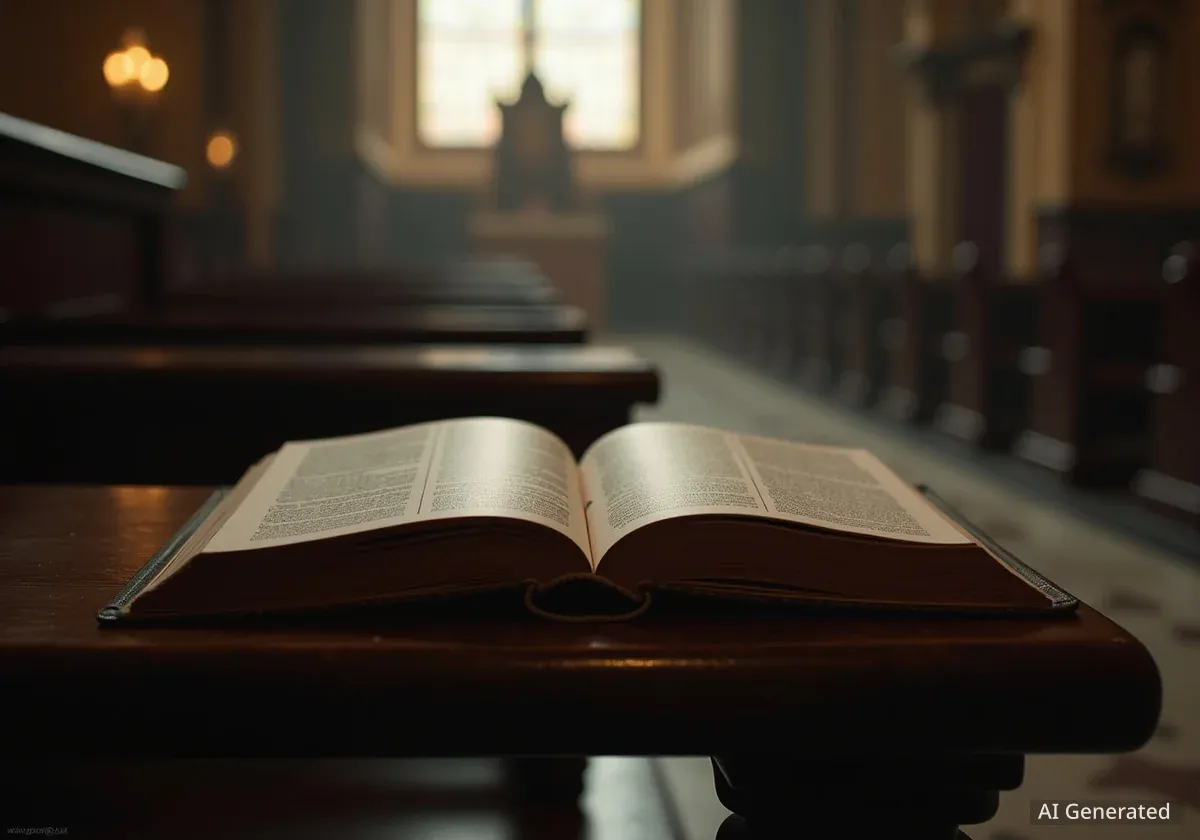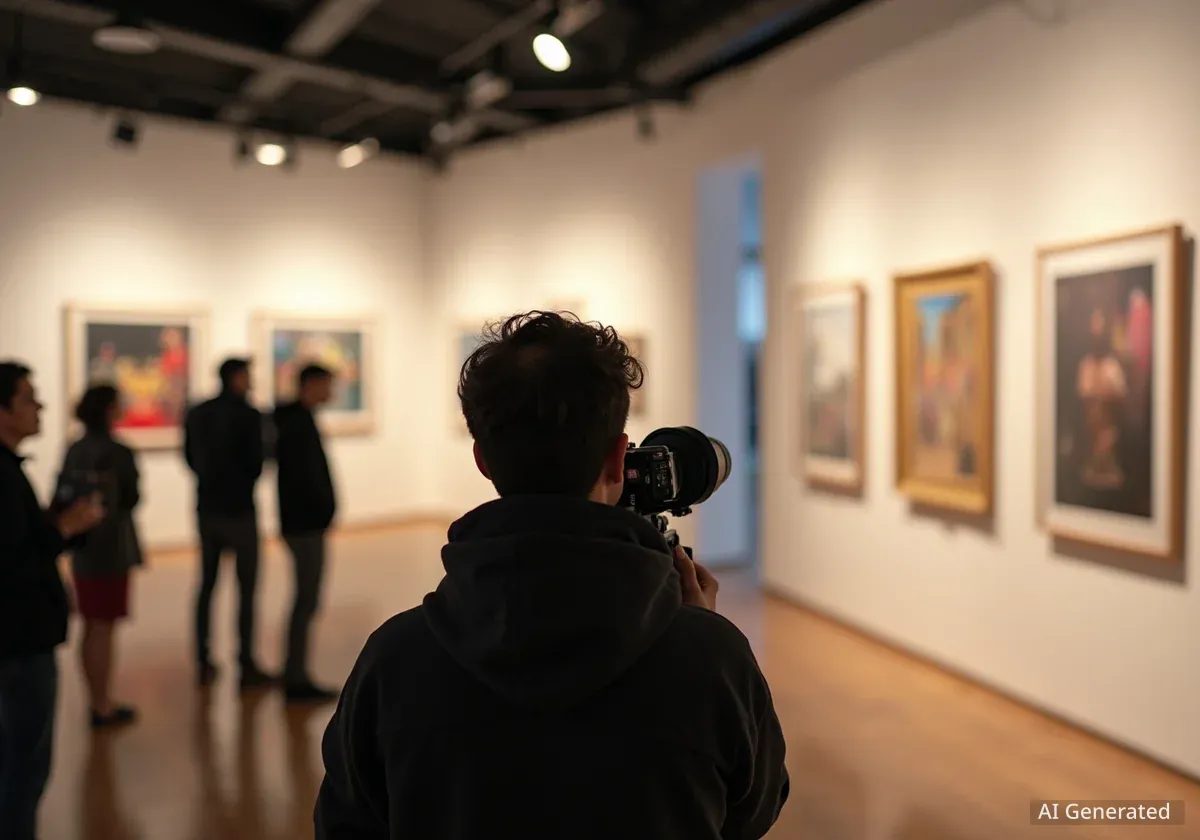Art historian Andrew Graham-Dixon has presented a new theory about Johannes Vermeer, suggesting his works carry a deep religious meaning tied to a persecuted Protestant group. This research, detailed in his new book, Vermeer: A Life Lost and Found, proposes that the Dutch master's iconic paintings, including Girl with the Pearl Earring, served as spiritual guides for a clandestine community.
Key Takeaways
- Vermeer's art may have served as spiritual instruction for a hidden religious group.
- The painter's patrons, the Van Ruijvens, were central to this tolerant sect.
- The 'Girl with the Pearl Earring' subject could be Magdalena van Ruijven.
- The painting The Little Street is identified as the Van Ruijven home.
- Vermeer's parents had strong ties to the Remonstrant Brotherhood.
Unraveling Vermeer's Hidden World
Andrew Graham-Dixon's six years of research have led to what he calls a "double discovery" regarding Vermeer. He believes he has found a satisfying explanation for Vermeer's artistic purpose. This explanation connects the artist to a previously overlooked group of people. These individuals were members of a persecuted religious community in 17th-century Delft.
Graham-Dixon's detective work focuses on the close circle around Vermeer. This circle included patrons, neighbors, and benefactors. These individuals were part of a religious group that faced repression. Their influence, Graham-Dixon argues, shaped Vermeer's art in profound ways.
Historical Context: 17th-Century Netherlands
The Netherlands in the 17th century was a new independent state, having recently separated from Spain. Austere Calvinism was the dominant religion. However, liberal merchants promoted religious tolerance, allowing other faiths to worship with some freedom. This period also saw significant internal conflicts among Calvinists, leading to schisms and accusations of heresy. The infamous Delft Thunderclap in 1654, a gunpowder explosion, devastated a quarter of the city, killing many, including painter Carel Fabritius.
The Influence of Tolerant Religious Groups
The core of Graham-Dixon's theory lies in the religious beliefs of Vermeer's inner circle. He suggests that figures like Baruch Spinoza, Erasmus, and theologian Jacobus Arminius played a role. Arminius, a young intellectual, led a liberal movement known as Arminianism. This tradition advocated against doctrinal disputes and for peace with other religious groups, including Catholics, Mennonites, and Jews.
The followers of Arminius issued a "remonstrance of protest" in 1610. They were then expelled from the main church and went into hiding. This led to the formation of the Remonstrant Brotherhood, a covert and tolerant sect. Graham-Dixon has found evidence linking Vermeer's parents to these clandestine followers.
"It has been emotional at times," Graham-Dixon states. "I kept thinking: 'How did I never see the connections?' I have now met all these wonderful historic characters. Half of them were just hiding behind the furniture."
Vermeer's Ties to the Collegiants
Graham-Dixon is convinced that Vermeer himself was a member of an even more self-effacing splinter group: the Collegiants. This faction rejected formal rituals of faith, churches, and priests. Their services were simple domestic gatherings. Religious observance meant following practical guidelines from Christ and the humble example of Mary Magdalene. This group directly influenced the Quakers in England.
Did You Know?
- Vermeer lived from 1632 to 1675 in Delft.
- Only 36 of his paintings are known to exist today.
- He is often called "the Sphinx of Delft" due to the mystery surrounding his life.
- His mother, Digna, was a migrant from Antwerp.
"These were radicals who wanted to get rid of churches and priests," Graham-Dixon explains. "They wanted no organization and no ministry. Their texts were still written by men, but women had freedom of utterance for the first time." He adds that Collegiants had no beliefs beyond Christian teachings like "Love thine enemy" and "Suffer the little children." He suggests that many people today are "actually Collegiants without knowing it."
The Role of Patrons: The Van Ruijven Family
Vermeer's mother, Digna, had been taken in by wealthy Remonstrants in Amsterdam as a young migrant. Graham-Dixon discovered that this family later linked directly to Arminius's descendants through marriage. This finding caused him to rewrite the beginning of his book.
Graham-Dixon acknowledges that he was not the first to suspect Vermeer's connection to nonconformists. John Michael Montias, a prominent Dutch art scholar, had hinted at this link years ago. Montias had encouraged art historians to pursue a trail connecting Vermeer's chief patrons to a banned religious group.
Documents show that Vermeer's father, Reynier, a silk weaver, asked Johannes Taurinus, a leading secret Remonstrant in Delft, to sign his marriage paperwork. This allowed Reynier to marry Digna in Amsterdam, avoiding a Calvinist relative. Graham-Dixon speculates that Vermeer might have been named after Johannes Taurinus.
After marriage, Vermeer's parents moved to Delft and ran an inn called the Flying Fox. They became close to a small group of Remonstrants, particularly the wealthy Van Ruijven family. This family is credited with commissioning almost all of Vermeer's most famous works.
Vermeer painted almost exclusively for the Van Ruijvens from about 1657 for 13 years. When this arrangement ended, he largely stopped painting. Graham-Dixon describes this as "an arrangement without parallel in the history of art."
Identifying Key Figures and Locations
Research by the Rijksmuseum in Amsterdam for its 2023 Vermeer exhibition supports the idea that Maria de Knuijt, the Van Ruijven matriarch, was the artist's true patron, not her husband, Pieter van Ruijven. Maria de Knuijt held covert Collegiant meetings in her house on Oude Delft, located near the hidden Remonstrant church.
Graham-Dixon proposes that the Van Ruijvens' daughter, Magdalena, was the mystery subject of several of Vermeer's best-known portraits. If this is true, then Magdalena van Ruijven is the Girl with the Pearl Earring.
Furthermore, Graham-Dixon identifies the Van Ruijven home as the actual site depicted in the painting The Little Street. He confidently points out the facade of this former home on Oude Delft as the exact location.
The Spiritual Purpose of Vermeer's Art
Graham-Dixon believes Vermeer's paintings were devotional. They were created to aid the worship of those meeting secretly in the Van Ruijven house. Each picture, he argues, expresses some aspect of these tolerant beliefs.
He uses The Milkmaid and Woman Holding a Balance as examples. These two paintings are similar in size, light, and setting. In both, a bare nail protrudes from the wall at the same point. Graham-Dixon interprets this as the Remonstrant symbol for the crucifixion. He argues that the paintings depict two sides of religious life:
- The Milkmaid represents "charitable" life, showing a woman preparing food for the poor.
- Woman Holding a Balance represents "contemplative" life, where a woman weighs her soul.
These works have never been paired this way before. However, Graham-Dixon says that once seen as a pair, the connection becomes clear. Recognizing the portraits as instructive panels explains their mood of gentle concentration. "Vermeer was not driven by fame nor money, but by some deep feeling or belief," Graham-Dixon states.
Reception and Legacy of the New Theory
Graham-Dixon acknowledges that his theory is "largely and perhaps disconcertingly new." He writes in his book that this is a side of Vermeer that has been lost from view, though many who love his work may have sensed its presence. He stresses that his aim is not originality for its own sake.
The theory has already gained support from Paul Abels, a Dutch expert on religion. Abels judges Graham-Dixon's findings "essentially right." He adds, "You’ve made it clear that Vermeer’s paintings are not simply atmospheric genre pieces, but coded works with a deeply religious meaning. This is totally new."
The book challenges the common academic view that Vermeer converted to Catholicism. It also questions the idea that he merely recorded domestic scenes with realism, mimicking a camera obscura. Graham-Dixon expects pushback from specialists but welcomes other viewpoints, consistent with Collegiant ideals of tolerance.
Notable Figures Connected to Vermeer's Circle
- Baruch Spinoza: Likely a friend of Vermeer.
- Erasmus: His legacy influenced the tolerant views.
- Jacobus Arminius: Theologian whose ideas shaped the Remonstrant movement.
- Adriaen Paets: Enlightened arts patron and director of the Dutch East India Company.
Graham-Dixon describes a pivotal moment in his research. He realized that marrying a Catholic was consistent with a true Remonstrant belief in tolerance. Remonstrants and Collegiants allowed members of other faiths to establish their own "colleges."
The "penny really dropped," he says, when he saw a note of the last large cash loan to Vermeer. It came from Arminius’s grandson. This solidified his understanding that the Van Ruijven portraits were devotional paintings, meant to aid worship within their secret meetings.
A Final Discovery: The Dissius Collection
The narrative concludes with an event from 1695, two decades after Vermeer's death. A notary clerk in Delft took inventory of a collection belonging to Jacob Dissius, a printer. The clerk unknowingly stumbled upon an extraordinary art collection. It contained all of Vermeer's paintings that had belonged to the Van Ruijvens. These works were inherited by Magdalena, the daughter who married Dissius and moved to a building known as "the Golden ABC."
Upon Magdalena's early and childless death, Dissius became the custodian of 20 personal pictures by Vermeer. This represented nearly two-thirds of Vermeer's known output. Graham-Dixon believes these tranquil works remained together because they conveyed a peaceful Collegiant creed. He interprets this creed as: "Hatred is increased by being reciprocated, and can, on the other hand, be destroyed by love." Understanding this, he says, has been the true reward of his research.




